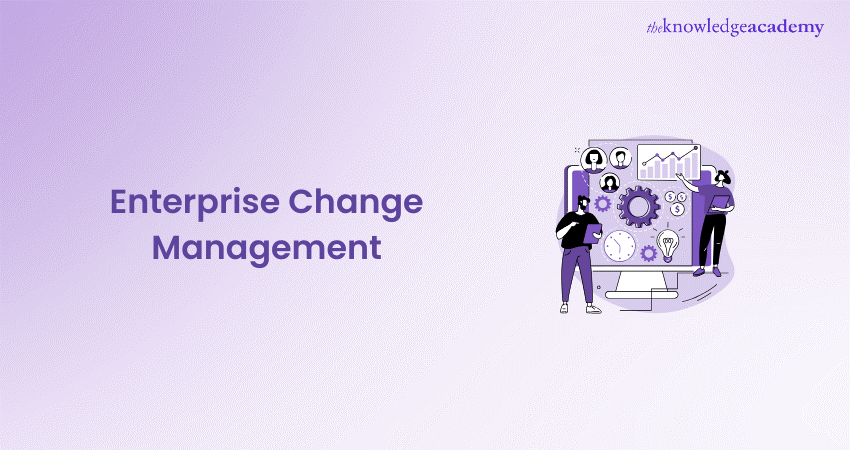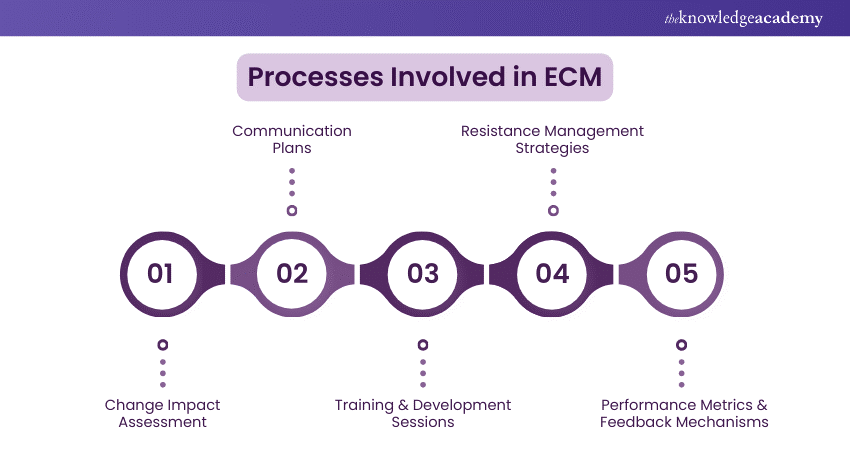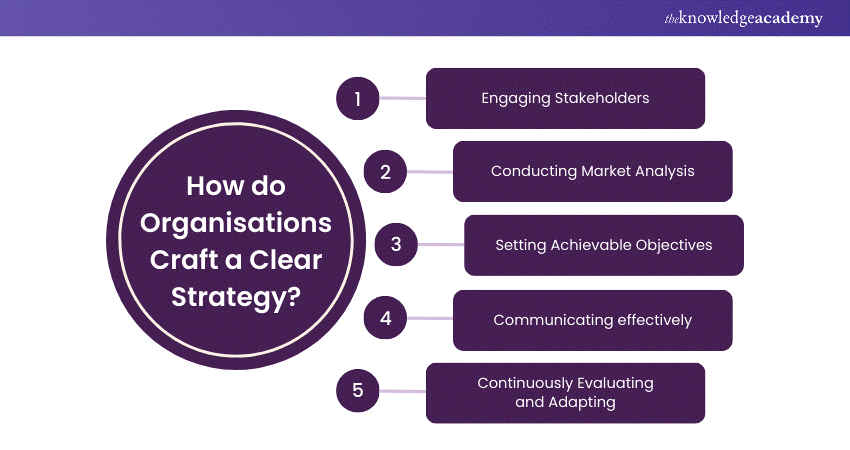We may not have the course you’re looking for. If you enquire or give us a call on +44 1344 203 999 and speak to our training experts, we may still be able to help with your training requirements.
Training Outcomes Within Your Budget!
We ensure quality, budget-alignment, and timely delivery by our expert instructors.

At its core, Enterprise Change Management (ECM) is the compass guiding organisations toward resilience and adaptability. Imagine it as the North Star that helps businesses not only weather market storms but also thrive amidst change.
Picture this: industry giants navigating the choppy waters of market volatility and technological shifts. ECM is their secret weapon—the strategic approach that fuels continuous improvement and fosters a culture of adaptability.
In this blog, we’ll explore curated examples where Enterprise Change Management has been the catalyst for remarkable transformations. Brace yourself for insights that could redefine your organisation’s trajectory!
Table of Contents
1) What is Enterprise Change Management?
2) Key Components of Enterprise Change Management
3) Four Successful Enterprise Change Management Examples
4) Tips for Effective Enterprise Change Management
5) Conclusion
What is Enterprise Change Management?
Enterprise Change Management (ECM) is the structured approach that organisations employ to manage and implement changes effectively across their entire enterprise. It involves planning, coordinating, and guiding individuals, teams, and departments through transitions to achieve desired outcomes while minimising resistance and disruptions.
Key Components of Enterprise Change Management
Here are the key components essential for effective Enterprise Change Management:
1) Common Processes and Tools
There are established frameworks, methods, and digital platforms that provide a structured approach to managing change initiatives.

By standardising processes and leveraging technology, organisations can streamline communication, collaboration, and decision-making, enhancing efficiency and effectiveness in Change Management efforts.
2) Leadership Competency
Strong leadership capable of inspiring, motivating, and guiding employees through change, fostering a culture of resilience and adaptability. Effective leaders exhibit qualities such as vision, empathy, communication, and decisiveness, empowering teams to embrace change, navigate uncertainty, and overcome challenges with confidence and optimism.
3) Strategic Capability
Strategic capability involves an organisation’s ability to anticipate, assess, and respond to changes in the external environment. It encompasses foresight, agility, and responsiveness. By proactively identifying emerging trends, seizing opportunities, and mitigating risks, organisations can maintain a competitive edge in dynamic markets.
Lead transformational initiatives and drive tangible results – join our Change Management Foundation Course now!
Four Successful Enterprise Change Management Examples
Here are some of the most compelling Enterprise Change Management examples from global corporations that have successfully navigated transformation:
1) Starbucks
Starbucks exemplifies the significant benefits of customer feedback. It was set up in 1971 by Jerry Baldwin, Zev Siegl, and Gordon Bowker and later acquired by Howard Schultz in 1987, Starbucks faced a downturn during the 2008 financial crisis, leading to the closure of nearly 1,000 stores and a 28% drop in earnings.
In response, the “My Starbucks Idea” platform was launched, engaging customers directly and implementing over 100 of their ideas, fostering a community of enthusiasts and baristas. Now, Starbucks boasts a global presence with 32,660 stores and a growing workforce.
2) Netflix
Netflix’s story is one of strategic adaptation; starting as a Digital Versatile Disc (DVD) rental alternative in 1997, it shifted to streaming in 2007, anticipating the future of entertainment. This Change Management mastery has made Netflix a leading subscription service and an integral part of modern culture.
Discover what is Change Management and how it can drive success in your organization. Learn more!
3) General Electric
Jack Welch’s tenancy as CEO of General Electric saw the company’s value soar from £9,38,00 billion to £2,19,11,40 billion. He made this possible by implementing Six Sigma and a customer-centric approach, positioning GE as a global business leader.
4) Domino's Pizza
Domino’s Pizza’s recovery from its 2008 low is a testament to effective Change Management. Embracing technology and digital innovation, Domino’s revitalised its operations and customer engagement, exploring new delivery methods and creating a data-driven strategy to enhance customer experience and loyalty.
Equip your team with our Managing Change With Agile Methodology Training - join us and embrace the change with confidence!
Tips for Effective Enterprise Change Management
Navigating change in the enterprise landscape requires strategic planning and effective execution. Here are some tips to enhance the success of your Change Management efforts:
1) Develop a Clear Vision and Strategy
Communicate the rationale for change, articulate the desired outcomes, and outline a roadmap for implementation.

This clarity inspires confidence, aligns efforts, and ensures everyone understands their role in achieving organisational goals, fostering a sense of purpose and direction.
2) Create a Roadmap with Accountability
Establish clear milestones, roles, and responsibilities to record progress and ensure accountability at every stage of the change process. By defining clear expectations and holding individuals and teams accountable, organisations can maintain momentum, drive progress, and mitigate risks.
3) Address Emotional and Psychological Aspects of Change
Recognise and empathise with employees' concerns, fears, and resistance to change, providing support and resources to help them navigate through uncertainty. Acknowledging emotions validates employees' experiences, builds trust, and fosters a supportive environment conducive to successful change adoption.
4) Secure Leadership Commitment and Support
Engage leaders as champions of change, fostering a culture of openness, trust, and collaboration across the organisation. Leadership commitment sets the tone for change, inspires confidence, and empowers employees to embrace new ways of working, driving alignment and resilience throughout the organisation.
5) Align Change with Organisational Culture
Ensure that change initiatives are compatible with the values, norms, and beliefs that define the organisation's culture, promoting acceptance and adoption. Cultural alignment fosters authenticity, enhances employee engagement, and cultivates a sense of belonging, facilitating smoother transitions and sustainable change outcomes.
Discover the Best Change Management Books! Read our top picks and transform your organization today!
6) Utilise Digital Tool
Harness technology to facilitate communication, automate processes, and provide real-time insights into the impact of change on operations and performance. Digital tools streamline collaboration, enhance visibility, and empower stakeholders with data-driven decision-making capabilities, accelerating change implementation and driving efficiencies.
7) Provide Contextual, Role-Based Onboarding and Training
Customise training and development sessions to meet the specific needs and preferences of different groups and individuals, promoting skills development and confidence in embracing change. Contextualised training increases relevance and engagement, equipping employees with the capabilities and knowledge needed to thrive in the evolving work environment.
8) Offer Continuous, Real-Time Support for End-Users
Establish channels for feedback, assistance, and troubleshooting to address concerns and issues promptly, ensuring a smooth transition and optimal user experience. Real-time support enhances user satisfaction, minimises disruptions, and stimulates a culture of continuous improvement, enabling organisations to respond swiftly to evolving needs and challenges.
9) Continuously Evaluate Processes, Performance, and Productivity
Monitor and evaluate the efficacy of change initiatives, gathering feedback, analysing data, and making adjustments as necessary to optimise outcomes and drive continuous improvement. Ongoing evaluation enables organisations to identify opportunities for refinement, address bottlenecks, and maximise the value of change investments, fostering agility and resilience in dynamic environments.
Equip your team with essential skills to navigate uncertainty and drive positive outcomes – join our Risk Management For Change Training!
Conclusion
Discover how Enterprise Change Management (ECM) can transform challenges into victories. Learn from real-world Enterprise Change Management Examples how strategic ECM approaches empower businesses to thrive. Let these success stories inspire innovation on your own organizational journey. Additionally, explore the impact of change management salary on ECM implementation and organizational success.
Gain the skills to lead seamless transitions and drive success – join our Change Management Practitioner Course today!
Frequently Asked Questions

The three key objectives for enterprise Change Management are to ensure smooth transitions, minimise resistance, and achieve desired outcomes by aligning organisational strategies with change initiatives.

Change management impacts staff by influencing their morale, productivity, and ability to adapt. Effective management fosters engagement, reduces uncertainty, and promotes a positive culture conducive to success.

The Knowledge Academy takes global learning to new heights, offering over 30,000 online courses across 490+ locations in 220 countries. This expansive reach ensures accessibility and convenience for learners worldwide.
Alongside our diverse Online Course Catalogue, encompassing 17 major categories, we go the extra mile by providing a plethora of free educational Online Resources like News updates, Blogs, videos, webinars, and interview questions. Tailoring learning experiences further, professionals can maximise value with customisable Course Bundles of TKA.

The Knowledge Academy’s Knowledge Pass, a prepaid voucher, adds another layer of flexibility, allowing course bookings over a 12-month period. Join us on a journey where education knows no bounds.

The Knowledge Academy offers various Change Management Courses, including the Change Management Practitioner Course, Change Management Foundation Training, and Risk Management for Change Training. These courses cater to different skill levels, providing comprehensive insights into Change Management Activities with Examples.
Our Project Management Blogs cover a range of topics related to Change Management, offering valuable resources, best practices, and industry insights. Whether you are a beginner or looking to advance your Project Management skills, The Knowledge Academy's diverse courses and informative blogs have got you covered.
Upcoming Project Management Resources Batches & Dates
Date
 Change Management Foundation & Practitioner
Change Management Foundation & Practitioner
Mon 6th Jan 2025
Mon 13th Jan 2025
Mon 20th Jan 2025
Mon 27th Jan 2025
Mon 3rd Feb 2025
Mon 10th Feb 2025
Mon 17th Feb 2025
Mon 24th Feb 2025
Mon 3rd Mar 2025
Mon 10th Mar 2025
Mon 17th Mar 2025
Mon 24th Mar 2025
Mon 31st Mar 2025
Mon 7th Apr 2025
Mon 28th Apr 2025
Mon 12th May 2025
Mon 19th May 2025
Mon 9th Jun 2025
Mon 23rd Jun 2025
Mon 7th Jul 2025
Mon 21st Jul 2025
Mon 4th Aug 2025
Mon 18th Aug 2025
Mon 1st Sep 2025
Mon 15th Sep 2025
Mon 29th Sep 2025
Mon 13th Oct 2025
Mon 20th Oct 2025
Mon 27th Oct 2025
Mon 3rd Nov 2025
Mon 10th Nov 2025
Mon 17th Nov 2025
Mon 24th Nov 2025
Mon 1st Dec 2025
Mon 8th Dec 2025
Mon 15th Dec 2025







 Top Rated Course
Top Rated Course



 If you wish to make any changes to your course, please
If you wish to make any changes to your course, please


